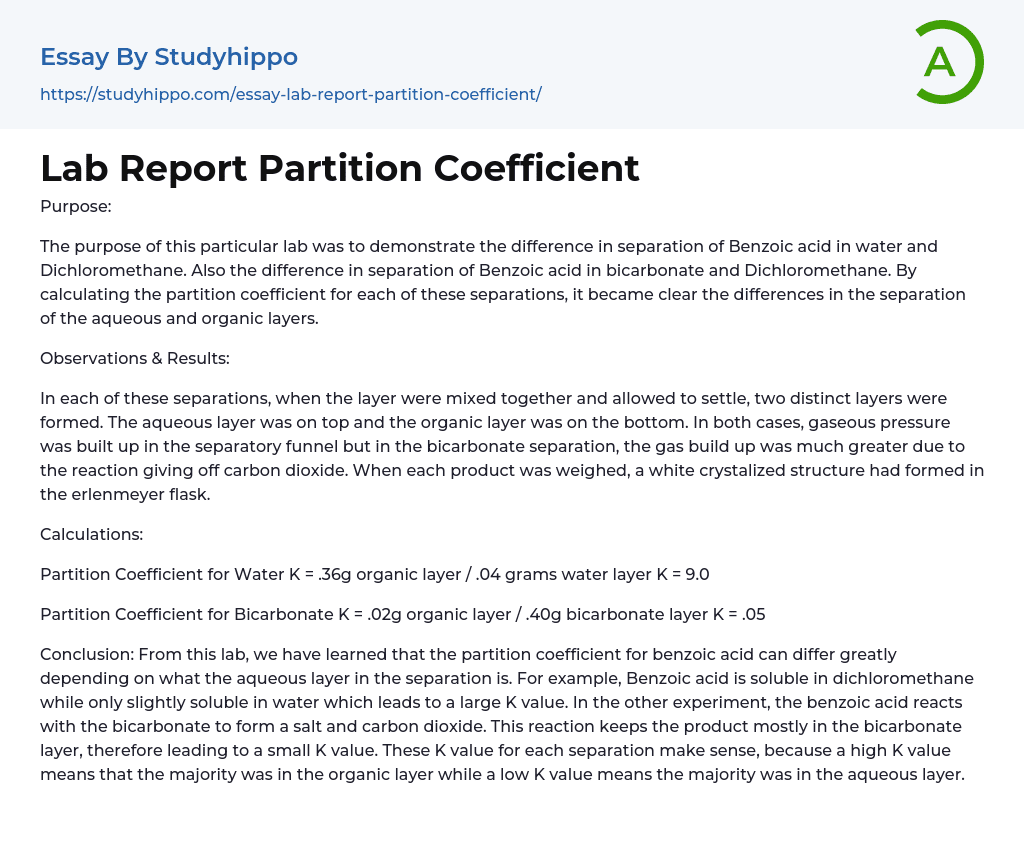Purpose:
The purpose of this particular lab was to demonstrate the difference in separation of Benzoic acid in water and Dichloromethane. Also the difference in separation of Benzoic acid in bicarbonate and Dichloromethane. By calculating the partition coefficient for each of these separations, it became clear the differences in the separation of the aqueous and organic layers.
Observations & Results:
In each of these separations, when the layer were mixed together and allowed to settle, two distinct layers were formed. The aqueous layer was on top and the organic layer was on the bottom. In both cases, gaseous pressure was built up in the separatory funnel but in the bicarbonate separation, the gas build up was much greater due to the reaction giving off carbon dioxide. When each product was weighe
...d, a white crystalized structure had formed in the erlenmeyer flask.
Calculations:
Partition Coefficient for Water K = .36g organic layer / .04 grams water layer K = 9.0
Partition Coefficient for Bicarbonate K = .02g organic layer / .40g bicarbonate layer K = .05
Conclusion: From this lab, we have learned that the partition coefficient for benzoic acid can differ greatly depending on what the aqueous layer in the separation is. For example, Benzoic acid is soluble in dichloromethane while only slightly soluble in water which leads to a large K value. In the other experiment, the benzoic acid reacts with the bicarbonate to form a salt and carbon dioxide. This reaction keeps the product mostly in the bicarbonate layer, therefore leading to a small K value. These K value for each separation make sense
because a high K value means that the majority was in the organic layer while a low K value means the majority was in the aqueous layer.
- Acid Rain essays
- Acid essays
- Calcium essays
- Carbohydrate essays
- Carbon essays
- Chemical Bond essays
- Chemical Reaction essays
- Chemical reactions essays
- Chromatography essays
- Concentration essays
- Copper essays
- Diffusion essays
- Ethanol essays
- Hydrogen essays
- Organic Chemistry essays
- Osmosis essays
- Periodic Table essays
- Ph essays
- Salt essays
- Sodium essays
- Titration essays
- John Locke essays
- 9/11 essays
- A Good Teacher essays
- A Healthy Diet essays
- A Modest Proposal essays
- A&P essays
- Academic Achievement essays
- Achievement essays
- Achieving goals essays
- Admission essays
- Advantages And Disadvantages Of Internet essays
- Alcoholic drinks essays
- Ammonia essays
- Analytical essays
- Ancient Olympic Games essays
- APA essays
- Arabian Peninsula essays
- Argument essays
- Argumentative essays
- Art essays
- Atlantic Ocean essays
- Auto-ethnography essays
- Autobiography essays
- Ballad essays
- Batman essays
- Binge Eating essays
- Black Power Movement essays
- Blogger essays
- Body Mass Index essays




